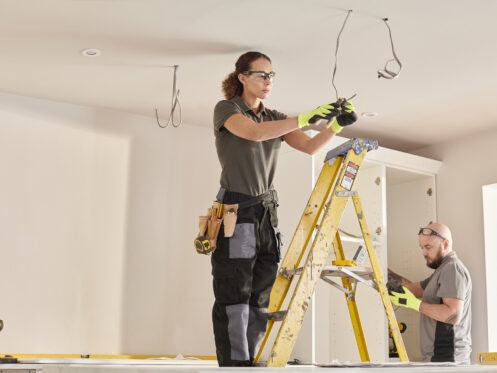Turning the lights on in your Lincoln, NE home shouldn’t fill you with dread. You don’t have to wile away your hours in darkness just to keep your energy bill down. Instead, you can enjoy the mood-setting comfort and limitless convenience of a flexible layered lighting plan. From task lights and under-counter lighting to wall sconces and pendant lights, it’s possible to have good-looking, multi-layer illumination without spending a veritable fortune. In fact, according to the United States Department of Energy (DOE), the right energy-efficient lighting will give you the same amount of illumination for about $225 less each year. The following are eight energy-efficient lighting options that you’re sure to love.
1. Unify and Save With LED Light Bulbs
As per the DOE, light-emitting diode (LED) light bulbs have lifespans that are 25 times longer than standard incandescent bulbs, and they use about 90% less energy. As such, they’re currently the gold standard in energy-efficient lighting. Moreover, they’re a lot more versatile and aesthetically pleasing than most consumers think. You can get a warm, daylight glow from LED bulbs by choosing them in the 2,500k to 2,700k range. To optimize your lighting aesthetics, shop for high-quality LED light bulbs that are streamlined to suit individual applications.
Switching to LED lighting won’t just lower your energy bill, it will also give you the opportunity to enhance the look and ambiance of your home. Many households currently have a mix of incandescent bulbs and LED bulbs that leave them with a mish-mash of lighting temperatures, colors, and intensities. By taking a purist approach to your lighting, you can instantly give your living space a more unified and polished appearance overall.
2. Use Diffusion to Make Your Current Lighting More Expansive
Before you rush out and spend a ton of money on all-new lighting, consider diffusing the light from some of your existing fixtures instead. Use paper or fabric shades, bulbs with opaque glass, or paper globes to add layers to your indoor illumination, focus lighting, or splay it.
3. Install Dimmer Switches
Dimmer switches aren’t just for setting the mood. Sure, they work well when hosting an intimate dinner, but they’re also surprisingly efficient. Light dimmers decrease energy use by limiting the flow of electricity to connected fixtures so that bulbs can operate at reduced power outputs.
When incorporating dimmer switches into your energy-efficient lighting plan, don’t stop at your dining room. You can install these switches in bedrooms, family rooms, dens, kitchens, and bathrooms.
4. Choose Smart Lights for High-Use Areas
Smart lights are at the cutting edge of innovation. Next to LED bulbs, they’re a top choice for energy-efficient illumination. These light bulbs and light fixtures can sense their environments, the presence and movement of building residents, and the activities of other smart devices and appliances throughout the building. Smart bulbs can interact with other smart home features too.
This level of functionality allows smart lights to adjust their own performance to suit. For instance, if you and all other residents leave the vicinity, a smart light can dim or turn itself off. Smart lights can also be adjusted by consumers using voice commands, remote controls, or connected tablets, computers, and mobile phones.
5. Add Halogen Incandescent Bulbs to Your Lighting Plan
Halogen incandescent bulbs are about 25% more efficient than standard incandescent light bulbs. Although this doesn’t trump or even measure up to the efficiency of LED bulbs, it does give you another option for cutting your home energy costs. These bulbs also last two and a half times longer than standard options, and they’re perfect for areas in which you want a bright, white light, rather than lighting with a subtle orange glow. You can use these bulbs for task lighting, under-counter lighting, study lighting, and more. At the interior of a halogen incandescent bulb, a small capsule holds gas against the lighting filament. The result is a simple and incredibly lightweight design, easy and sustainable production, and less energy use overall.
6. Enhance Your Interior Lighting Design With Compact Fluorescent Lights
Compact fluorescent lights (CFLs) use about 70% less energy than standard incandescent bulbs. Although they’re not as efficient as LED lights, they’re certainly close. CFLs are available in a vast range of sizes, shapes, colors, and styles, and they work incredibly well with dimmer switches. Some options offer the same comforting, yellow-orange glow provided by standard incandescent lights, and others come with special covers for built-in light diffusion.
7. Give Your Home a Layered Look With Multi-Level Lighting
With interior design, less is often more. Incorporating just one or two of the latest design trends into your living space is infinitely more appealing than trying to use them all. However, when it comes to energy-efficient lighting, you may be surprised to discover that more is actually more. Having multiple options for illuminating every space allows residents to use only the energy and level of lighting they require.
For instance, if you’re working at a desk in an empty living room or curled up in a corner with a book, you might prefer to use a standing or table lamp rather than turning on the overhead light. These and other forms of task lighting give people tightly focused illumination that makes it easier to get their jobs done. If someone joins you and wants the overhead light on but dimmed, you’ll appreciate the focused illumination of your task lighting even more.
Layered lighting plans lie at the heart of universal interior design. They create spaces that function well for everyone in the home, regardless of their age, abilities, preferred activities, or interests. To get the best results from a layered lighting plan, try to establish at least three distinct layers using overhead lights, wall-mounted lights, and free-standing lighting.
If you know that your kids will be trooping back into the kitchen for a midnight snack, under-counter lights will provide adequate illumination to prevent trip-and-fall accidents and other noisy and painful events. By choosing smart lights for tasks and background lighting, you can also rest assured that these fixtures will adjust themselves or turn off as soon as local traffic dissipates.
8. Don’t Forget Your Windows
Natural lighting is a key element of any truly efficient lighting plan. After all, the sun’s light is free and it’s available all day during the warmer months of the year. However, to take advantage of this light without driving up your home cooling costs and subjecting residents, your flooring, and your furnishings to the damaging effects of UV rays, invest in a UV-blocking film for your windows or add adjustable, UV-blocking shades. The right window treatments will allow you to capitalize on natural light throughout the mid-portion of the day without watching your carpets and sofa fade, stressing out your air conditioner, or harming your skin.
We’re committed to helping residents of Anaheim, CA create safe, comfortable and highly efficient living environments. We offer heating, plumbing, cooling, sewer line repair, and electrical services. Our clients can also turn to us for UV sanitizers and duct cleaning. If you need help creating an efficient and multi-layered lighting plan, give John Henry's Plumbing, Heating, Air, and Electrical a call today.

